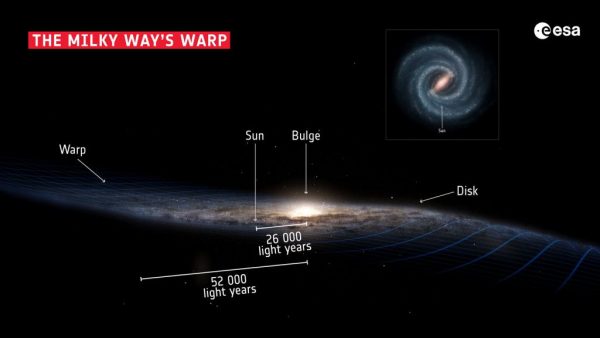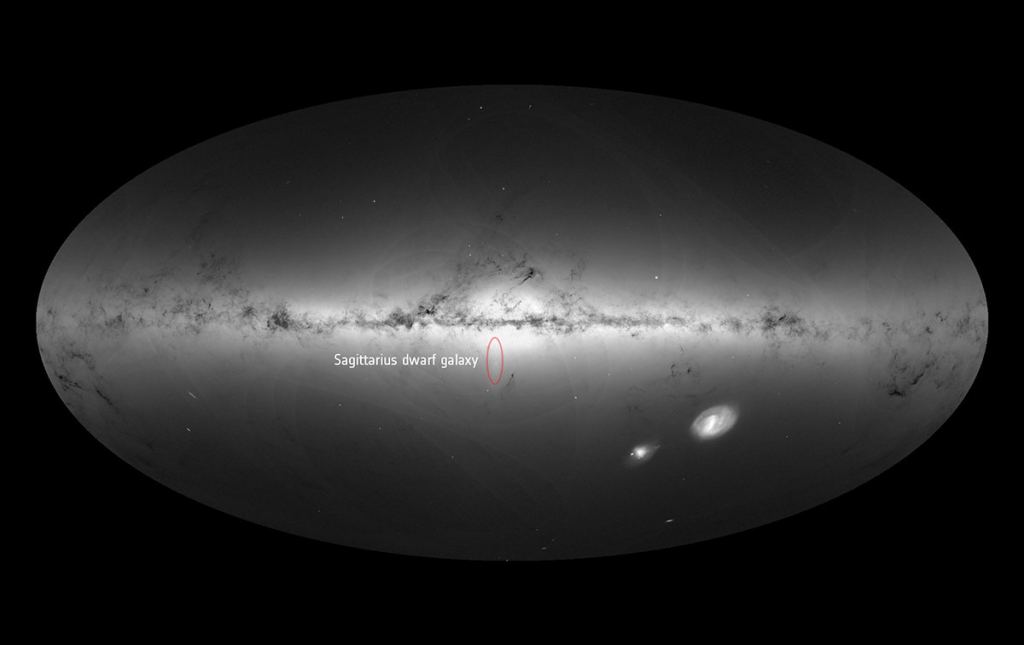The Disk of the Milky Way is Warped Because it Already Collided With Another Galaxy – Universe Today
For decades, astronomers have been trying to understand why the Milky Way galaxy is warped the way it is. In recent years, astronomers have theorized that it could be our neighbors, the Magellanic Clouds, that are responsible for this phenomenon. According to this theory, these dwarf galaxies pull on the Milky Way’s dark matter, causing oscillations that pull on our galaxy’s supply of hydrogen gas.
However, according to new data from the European Space Agency’s (ESA) star-mapping Gaia Observatory, it is possible that this warp is the result of an ongoing collision with a smaller galaxy. These findings confirm that the warp in our galaxy is not static, but subject to change over time (aka. precession), and that this process is happening faster than anyone would have thought!
Astronomers have known since the late 1950s that disk of the Milky Way, where most of its stars reside – is curved upwards on one side and downwards on the other. However, the reasons for this have remained unclear, with theories ranging from the influence of the intergalactic magnetic field, the gravitational effects of an irregularly-shaped dark matter halo.
To shed some light on this, a team of astronomers from the Turin Astrophysical Observatory in Italy and the Max Planck Institute for Astronomy in Germany consulted astrometric measurements from the second Gaia data release (DR2). This latest package (which was released on April 25th, 2018) contains updated information on the position, motion, and distances of 1.692 billion stars.
Using this data, the team was able to examine the behavior of stars located in the outer disk, from which they confirmed that the galaxy’s warp is not static but changes its orientation over time. This change in orientation, known as precession, is similar the same way that a planet experiences a “wobble” because of the way they rotate on their axis.
In addition, they also found that the precession of this warp is happening at a much faster rate than expected – far faster than what an intergalactic magnetic field or a dark matter halo would be capable of. The team concluded from this that something more powerful has to be influencing the shape of our galaxy, like a collision with another galaxy.

The study that describes their findings, titled “Evidence of a dynamically evolving Galactic warp“, recently appeared in the journal Nature Astronomy. As Eloisa Poggio of the Turin Astrophysical Observatory, who is the lead author of the study, explained in an ESA press release:
“We measured the speed of the warp by comparing the data with our models. Based on the obtained velocity, the warp would complete one rotation around the center of the Milky Way in 600 to 700 million years. That’s much faster than what we expected based on predictions from other models, such as those looking at the effects of the non-spherical halo.”
However, the speed of the warp’s precession is slower than the speed at which stars in the Milky Way disk are orbiting around the galactic center. For instance, our Sun orbits the center of the Milky Way at an average velocity of 230 km/s (828,000 km/h; 514,495 mph) and takes about 220 million years to complete a single orbit.
At present, it is unknown which galaxy might be causing the ripple or when the collision started. However, the team suspects that it could be the Sagittarius Dwarf Galaxy, an elliptically-shaped collection of about 10,000 stars that orbits the Milky Way from pole to pole, and at a distance of about 50,000 light-years.

Astronomers believe that this dwarf galaxy is gradually being absorbed by the Milky Way, a process that is believed to have caused it to crash through the Milky Way’s disk several times in the past. If the sound of this is making anyone feel nervous, they should take comfort in the fact that these changes are happening on a galactic scale and very far away – hence, they will have no noticeable effects on life on Earth.
This is research serves as an example of the unprecedented ability of the Gaia Observatory to map our galaxy in 3D, as well as the kinds of research that this makes. As Ronald Drimmel, a research astronomer at the Turin Astrophysical Observatory and a co-author of the paper, described it:
“It’s like having a car and trying to measure the velocity and direction of travel of this car over a very short period of time and then, based on those values, trying to model the past and future trajectory of the car. If we make such measurements for many cars, we could model the flow of traffic. Similarly, by measuring the apparent motions of millions of stars across the sky we can model large scale processes such as the motion of the warp.”
These findings are similar to other research findings that were made thanks to Gaia. In 2018, a team of astronomers used the first 22 months of mission data to determine that the Milky Way and other galaxies underwent collisions and mergers in the distant past, the evidence of which is still visible today in the motions of large groups of stars.
“With Gaia, for the first time, we have a large amount of data on a vast amount stars, the motion of which is measured so precisely that we can try to understand the large scale motions of the galaxy and model its formation history,” said Jos de Bruijne, the Gaia deputy project scientist. “This is something unique. This really is the Gaia revolution.”
The mission is currently in its sixth year and (barring extensions) will continue to gather astrometric data until 2022. In the meantime, astronomers are eagerly awaiting the next two releases of Gaia data (DR3 and DR4), which are planned for later in 2020 and in the second half of 2021. Given what we’ve already learned from this mission, one can only speculate as to the other mysteries it will help unravel!
Further Reading: ESA





